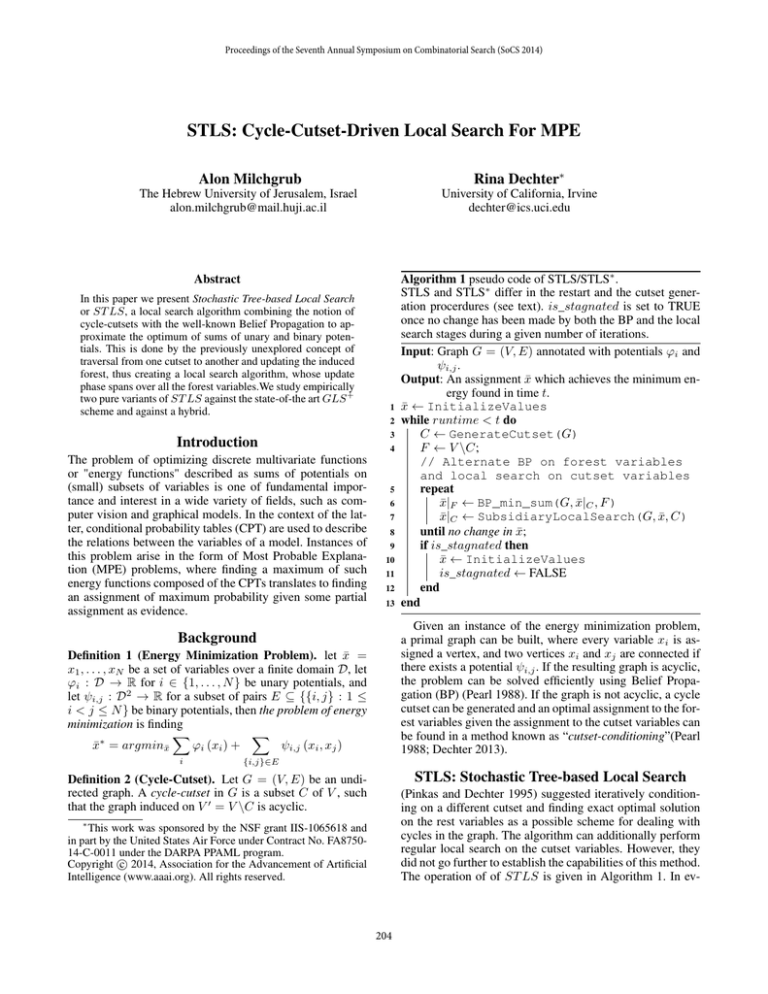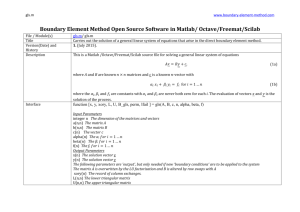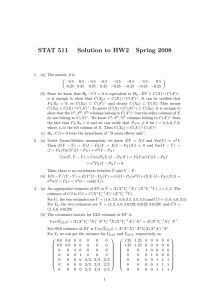
Proceedings of the Seventh Annual Symposium on Combinatorial Search (SoCS 2014)
STLS: Cycle-Cutset-Driven Local Search For MPE
Alon Milchgrub
Rina Dechter∗
The Hebrew University of Jerusalem, Israel
alon.milchgrub@mail.huji.ac.il
University of California, Irvine
dechter@ics.uci.edu
Abstract
In this paper we present Stochastic Tree-based Local Search
or ST LS, a local search algorithm combining the notion of
cycle-cutsets with the well-known Belief Propagation to approximate the optimum of sums of unary and binary potentials. This is done by the previously unexplored concept of
traversal from one cutset to another and updating the induced
forest, thus creating a local search algorithm, whose update
phase spans over all the forest variables.We study empirically
two pure variants of ST LS against the state-of-the art GLS +
scheme and against a hybrid.
1
2
Introduction
The problem of optimizing discrete multivariate functions
or "energy functions" described as sums of potentials on
(small) subsets of variables is one of fundamental importance and interest in a wide variety of fields, such as computer vision and graphical models. In the context of the latter, conditional probability tables (CPT) are used to describe
the relations between the variables of a model. Instances of
this problem arise in the form of Most Probable Explanation (MPE) problems, where finding a maximum of such
energy functions composed of the CPTs translates to finding
an assignment of maximum probability given some partial
assignment as evidence.
3
4
5
6
7
8
9
10
11
12
13
Given an instance of the energy minimization problem,
a primal graph can be built, where every variable xi is assigned a vertex, and two vertices xi and xj are connected if
there exists a potential ψi,j . If the resulting graph is acyclic,
the problem can be solved efficiently using Belief Propagation (BP) (Pearl 1988). If the graph is not acyclic, a cycle
cutset can be generated and an optimal assignment to the forest variables given the assignment to the cutset variables can
be found in a method known as “cutset-conditioning”(Pearl
1988; Dechter 2013).
Background
Definition 1 (Energy Minimization Problem). let x̄ =
x1 , . . . , xN be a set of variables over a finite domain D, let
ϕi : D → R for i ∈ {1, . . . , N } be unary potentials, and
let ψi,j : D2 → R for a subset of pairs E ⊆ {{i, j} : 1 ≤
i < j ≤ N } be binary potentials, then the problem of energy
minimization is finding
X
X
x̄∗ = argminx̄
ϕi (xi ) +
ψi,j (xi , xj )
i
Algorithm 1 pseudo code of STLS/STLS∗ .
STLS and STLS∗ differ in the restart and the cutset generation procerdures (see text). is_stagnated is set to TRUE
once no change has been made by both the BP and the local
search stages during a given number of iterations.
Input: Graph G = (V, E) annotated with potentials ϕi and
ψi,j .
Output: An assignment x̄ which achieves the minimum energy found in time t.
x̄ ← InitializeValues
while runtime < t do
C ← GenerateCutset(G)
F ← V \C;
// Alternate BP on forest variables
and local search on cutset variables
repeat
x̄|F ← BP_min_sum(G, x̄|C , F )
x̄|C ← SubsidiaryLocalSearch(G, x̄, C)
until no change in x̄;
if is_stagnated then
x̄ ← InitializeValues
is_stagnated ← FALSE
end
end
{i,j}∈E
STLS: Stochastic Tree-based Local Search
Definition 2 (Cycle-Cutset). Let G = (V, E) be an undirected graph. A cycle-cutset in G is a subset C of V , such
that the graph induced on V 0 = V \C is acyclic.
(Pinkas and Dechter 1995) suggested iteratively conditioning on a different cutset and finding exact optimal solution
on the rest variables as a possible scheme for dealing with
cycles in the graph. The algorithm can additionally perform
regular local search on the cutset variables. However, they
did not go further to establish the capabilities of this method.
The operation of of ST LS is given in Algorithm 1. In ev-
∗
This work was sponsored by the NSF grant IIS-1065618 and
in part by the United States Air Force under Contract No. FA875014-C-0011 under the DARPA PPAML program.
c 2014, Association for the Advancement of Artificial
Copyright Intelligence (www.aaai.org). All rights reserved.
204
Set
(# inst.)
STLS
Best
Ratio
STLS∗
Best
Hybrid
Ratio
Best
Ratio
GLS+ Random
Best
Ratio
GLS+
Best
% of
best
Grids
mean
2 (1)
1
2 (4)
1
17 (1)
1.02
0 (0)
0.75
0 (15)
95%
(21)
max
3 (2)
1.04
3 (9)
1.04
15 (2)
1.03
0 (0)
0.86
0 (8)
CSP
mean
15 (3)
1.19
14 (7)
1.18
13 (7)
1.17
20 (5)
1
21 (4)
77%
(29)
max
19 (1)
1.19
18 (5)
1.19
16 (11) 1.18
20 (5)
1
21 (4)
Protein. mean
2 (4)
1
0 (0)
0.99
3 (1)
1
5 (2)
1
5 (2)
100%
(9)
max
6 (1)
1
1 (2)
0.99
5 (2)
1
5 (1)
1
5 (2)
SGM.
mean 32 (29) 0.94
0 (6)
0.85
37 (40) 0.99
53 (33)
1
57 (32)
100%
(90)
max
37 (32) 0.96
30 (23) 0.96
42 (43) 0.99
55 (35)
1
52 (35)
Table 1: Statistics for average and maximal results over 10 runs on sets from PIC2011. The values presented refer to the results
obtained after 1 minute for the Segmentation set and 3 minutes for all other sets. Best is the number of the instances for whom
the algorithm achieved the best result (and second best in parenthesis). Ratio is the average ratio of the result obtained by the
algorithm to that of classic GLS+ . For GLS+ the average ratio of the result to the best overall result is presented.
ery iteration an optimal assignment to the forest variables
is generated given the values of the cutset variables using
BP min-sum. Therefore, the energy of the system can not increase from iteration to iteration and the resulting algorithm
is a local search algorithm finding the optimal solution on
all the forest variables in every iteration.
Two variants of ST LS were tested, one which used
the cutset selection procedure of (Becker, Bar-Yehuda, and
Geiger 2000) and a simple restart scheme, and a more complex variant named ST LS ∗ , which uses previous assignments to estimate a “certainty index”. The assignment history and the certainty index are used to heuristicly generate
new cutsets and in the initialization of restarts.
the Segmentation benchmark, the average ratios of the average and maximal results obtained by the various algorithms
to those of the classic GLS + range from slight superiority
for GLS + (ratio < 1) on the Segmentation benchmark to
significant dominance of the ST LS algorithms on the CSP
benchmark. This implies that while GLS + manages to produce the best results in many cases, it does not significantly
outperform ST LS and it struggles considerably on some instances. The overall improved performance of the hybrid implies that either algorithm acts as a mechanism for avoiding
local optima by the other, and suggests the union of both
algorithms as a promising trail for further improvement.
In future work, the algorithm should be extended to handle potentials of higher arity than 2 as well. Importantly,
ST LS yields strong local optima (conditional optimal on
every forest), and therefore, in the limit it is as good as minsum belief propagation in quality, while it can be more effective computationally. Comparing with specific loopy belief
propagation scheme is left for future work as well.
Experiments
The two variants of ST LS were compared to GLS + (Hutter, Hoos, and Stützle 2005), another local search algorithm,
considered for the last decade to be the state-of-the-art, as
well as to a simple hybrid of ST LS and GLS + . All algorithms were run 10 times on problems from the Grids, CSP,
ProteinFolding and Segmentation problem sets of the PASCAL2 Probabilistic Inference Challenge (PIC2011)1 (see
(Lee, Lam, and Dechter 2013) for a summary of the statistics of these benchmark sets). The resulting energies were
sampled after 0.1, 1, 10, 60, 120, and 180 seconds (Segmentation problems only up to 1 minute), and all the results of a
given instance were linearly normalized to the interval [0, 1],
mapping the worst result to 0 and the best to 1. In ST LS and
ST LS ∗ the variables were initialized to an undefined value,
thus ignored until obtaining a valid value. GLS + was initialized either randomly or using the customary Mini-Bucket
heuristic. The cutset variables were updated using the Hopfield Model activation function as the local search algorithm
mentioned in line 7 of Algorithm 1. See results in Table 1.
References
Becker, A.; Bar-Yehuda, R.; and Geiger, D. 2000. Randomized algorithms for the loop cutset problem. J. Artif. Int. Res.
12(1):219–234.
Dechter, R. 2013. Reasoning with Probabilistic and Deterministic Graphical Models: Exact Algorithms. Synthesis Lectures on Artificial Intelligence and Machine Learning. Morgan
& Claypool Publishers.
Hutter, F.; Hoos, H. H.; and Stützle, T. 2005. Efficient stochastic local search for mpe solving. In Proceedings of the 19th
International Joint Conference on Artificial Intelligence, IJCAI’05, 169–174. San Francisco, CA, USA: Morgan Kaufmann Publishers Inc.
Lee, J.; Lam, W.; and Dechter, R. 2013. Benchmark on daoopt
and gurobi with the pascal2 inference challenge problems. In
DISCML.
Pearl, J. 1988. Probabilistic Reasoning in Intelligent Systems:
Networks of Plausible Inference. San Francisco, CA, USA:
Morgan Kaufmann Publishers Inc.
Pinkas, G., and Dechter, R. 1995. Improving connectionist
energy minimization. J. Artif. Int. Res. 3(1):223–248.
Results and Future Work
As can be seen in Table 1, although the GLS + variants do
manage to produce the best results more often, especially in
1
http://www.cs.huji.ac.il/project/PASCAL/index.php
205






